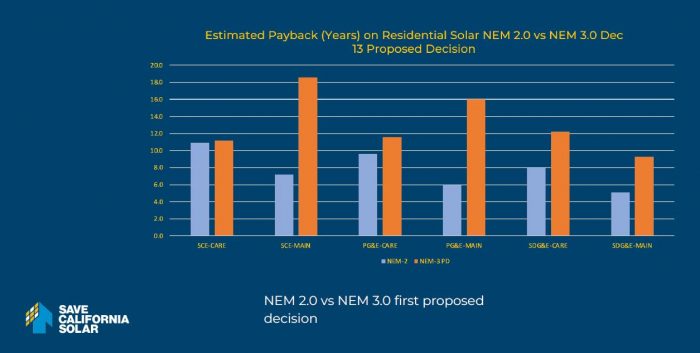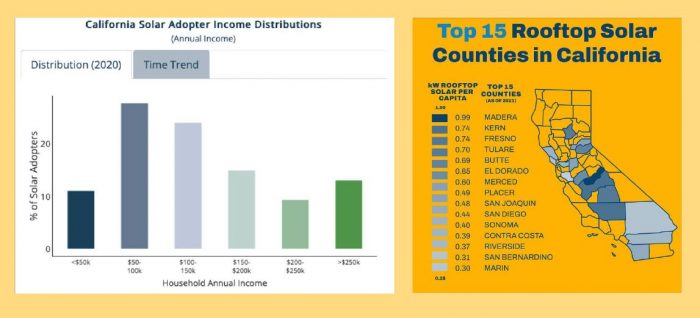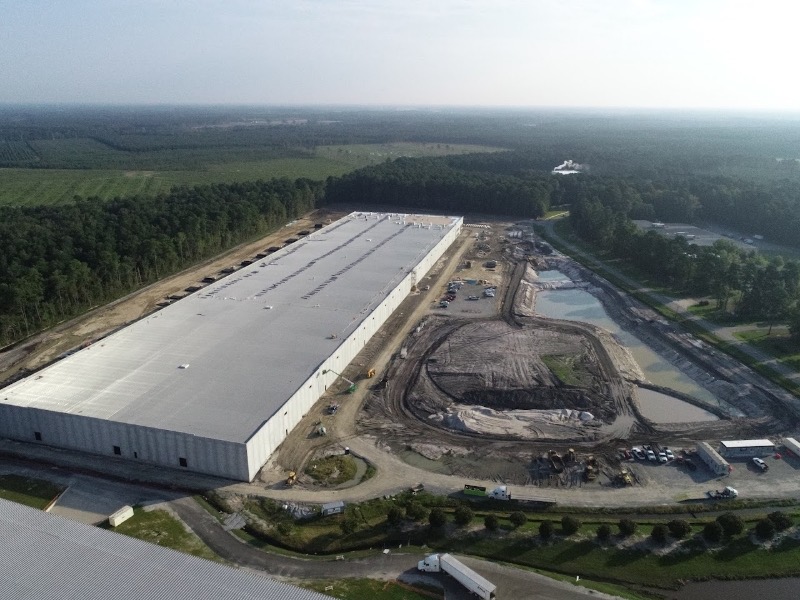California’s revised NEM 3.0 proposal is coming: Will it also miss the mark on equity?

California’s NEM. 30 proposed decision was delayed indefinitely in February after an uproar from industry analysts, environmental groups and just people in general. The time is drawing near for a revised proposal.
“We’re waiting everyday with bated breath for a revision,” says Bernadette Del Chiaro, Executive Director of the California Solar and Storage Association (CALSSA), during a recent media call. Once it’s released, there will be oral arguments as part of the proceedings and then a voting meeting.
The next public meeting is May 5. It’s unlikely to be released and then voted on at that meeting, but California’s PUC has no set rules in terms of a commentary time period, so it is still technically possible. And judging by the tone of the media call, and examples of social media posts from high ranking policy staffers in the PUC, CALSSA doesn’t seem hopeful the revision will be much better.
We have covered the projected implications of that initial proposal several times – how its combination of fixed charges and rate adjustments would add up to be the highest tax on home solar PV in the country, and how such a punitive structure would drastically decrease California’s home solar market and likely result in the loss of local jobs and businesses.
So, we won’t rehash that ground here.
The ground I’d like to hash instead is the logical fallacy of that first NEM 3.0 proposed decision, as a way to think about the revision when it does come out.
What is equity?

California’s home solar industry has heard it all in its years as it inched from nascent niche market to the behemoth that it is today, accounting for half of the state’s generated solar.
“There’s been an evolution of messages,” Del Chiaro recalls. “First, it was solar is unreliable, there was a lot of concern about cloud cover in the early 2000s. Then, it was too expensive as California investigated doing a massive rebate program.”
Then the market started to take off, which brought about the idea of a “death spiral” for utilities.
“That didn’t hold very long, this idea that the utilities were going to go bankrupt by virtue of people generating their own energy. So they had to come up with a different talking point,” Del Chiaro says, seeing it all as a concerted effort by the utilities to dissuade consumers from generating their own energy.
Which leads us to the current claim that home solar is hurting lower income residents by virtue of residents of means adding solar and causing a cost shift. The PUC is framing this as an equity issue now, and that talking point is underpinning of the most controversial aspects California’s NEM 3.0 proposal.
Aside from the slashing the value of home solar, that first proposal did include the establishment of an Equity Fund with up to $600 million “to help scale up low-income access to distributed clean energy. There would be a stakeholder process to determine the allocation of funds, which could go toward upfront incentives for distributed storage, community solar in low-income and disadvantaged communities, or other low-income clean energy programs with strong consumer protections.”
“Utility arguments about the cost shift are weaponizing equity,” is how Roger Lin, Senior Attorney, Center for Biological Diversity, phrased it on the call.
Lin says there are two equity issues at play here. The first is there aren’t enough low-income folks on solar.
“That’s a given. We don’t need a complicated study for that,” he laughs. Lin serves on the Disadvantaged Communities Advisory Group, which was formed in 2016 to help advice the PUC and California Energy Commission (CEC) on ways to overcome barriers to solar adoption. So, the have/ have-not aspect of residential solar is one he has given a lot of thought.
“The just transition is the real equity issue,” Lin says. “None of their proposals or proponents of the cost-shift arguments are looking at social costs such as local air quality, water quality, resiliency and jobs. They’re not looking at the disproportionate impacts of pollution in low-income communities or the social costs. The models they are using were inequitably created behind closed doors with inadequate input from the environmental justice community and now they are using those models to message an equity argument.”
“If we keep creating barriers to solar adoption then we won’t meet our climate or our equity goals.”
Equity also requires jobs.
The other thing lower income and poor people need is better, stable jobs. If you’re worried about equity, residential solar is a legit job creator. A study by Vibrant Clean Energy found that sustained investment in local solar and storage could create 100,000 jobs by 2030 and 374,000 jobs by 2050. Thus, enacting policy that is sure to hurt this market, will cost local jobs in the immediate.
CALSSA points to what happened in Nevada back in 2017, which passed NEM rate changes only half as punitive that still completely cratered the market and caused businesses to shut doors and leave the state.
Preserving the environment is also an equity issue. Prioritizing utility-scale solar over rooftop solar as a policy means you that you are prioritizing the use of land and greenspace.
“Rooftop solar also helps us protect our open spaces — we have a nature crisis as well,” notes Laura Deehan, State Director, Environment California. “We’re losing wildlife in rapid numbers. If we continue at existing pace, that would mean an additional 28.5 GW of large scale solar, which threatens 138,000 acres of land. … will need about a million acres to get to our clean energy goals. So, there’s a lot at stake if rooftop solar is harmed.”
Bills aren’t going up because of a cost shift.

Meanwhile, not all home solar adopters in California are rich these days. In 2020, around 35 percent of solar adopters were in the <$50,000 to $100,000 annual income range.
Even if solar is strictly a virtue of the wealthy, the benefits of that stored, renewable energy still freely aids the grid. In fact, the California grid needs this personally financed solar contribution, sometimes desperately. The CEC just touted a record peak of renewable energy usage on April 3, hitting 97.6 percent. In that mix was 12 GW of distributed solar. During 2020 heatwave, to combat rolling blackouts, energy regulators called on solar + storage industry to voluntarily modify charging and discharging of their batteries to meet the needs of the grid needs.
In an alternate world without solar PV, even if it was just some province of the wealthy, Californians all seem to benefit.
“What’s really increasing people’s bills would still increase bills so much more than what we have now,” Lin says. “The utilities are using inequitable models to hide massive transmission costs to prove an equity argument.” That’s how they are cherry picking the issue, in his assessment.
Lin notes that $4.336 billion in transmissions costs were paid by California ratepayers in 2020 alone, up 38 percent from 2016 statewide. From 2010 to 2019, investor-owned utilities charged ratepayers nearly $20 billion in transmission line projects, while collecting more than $20 billion in profits “over a similar time period,” CALSSA notes.
Value of an electron saved
An especially confusing idea surfacing in NEM 3.0 is taxing solar energy that’s self-consumed at the time of generation and not what is exported to the grid.
Exporting to the grid “is what net metering is — the value of that bill credit — which is what we should all be debating,” Del Chiaro says. “Instead they want to go behind the meter and tax what people do on their property … saying that energy self-consumed should have been purchased from the grid instead, and if it was, you would have paid us these charges.”
Conversely, California is the champion of promoting and investing in energy efficiency, something rightly touted as consumer bill savings. A lot of bill savings. Rooftop systems generate 19,000 GWh per year, 9,500 of which is self-consumed. CEC estimates that efficiency programs (building standards, appliance standards, other efficiency programs) now save roughly 80,000 GWh of energy from being consumed from the grid.
Of course, the CEC seems to realize this considering it mandated that all new homes and commercial buildings incorporate solar. That mandate juxtaposed with NEM 3.0 — which would charge home and building owners more to comply with their mandate — strains the claim of equity even more.
“Some policy makers in California, I would argue, are confused about the principles that have built California’s clean energy success to date,” Del Chiaro says. “Number one is using less energy from the grid is good for everybody. Nobody is talking about the electron not consumed via energy efficiency. Why are we demonizing the self-consumption of solar when we have nothing to say about energy efficiency. Not that we should, just pointing out this hypocrisy.”
Distributed solar is half of California’s market, and it needs much more. The CEC’s forecast shows 40 GW of rooftop solar is needed by 2045 to meet the state’s clean energy goals. Here’s hoping the PUC recognizes this reality in its next NEM 3.0 proposal and adjusts its models and concept of equity accordingly.





Comments are closed here.